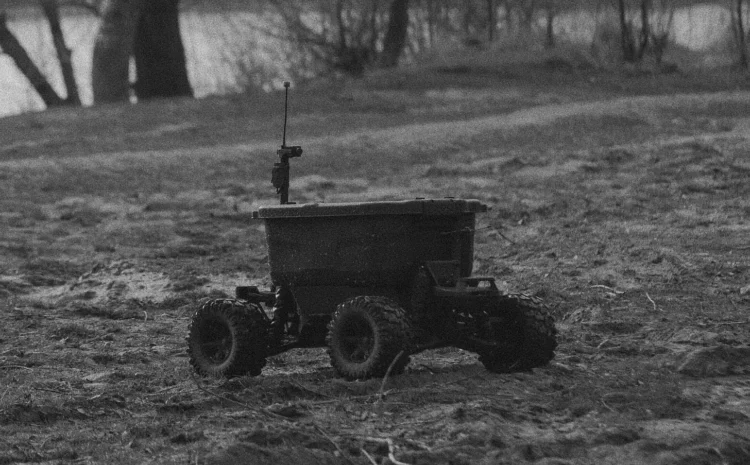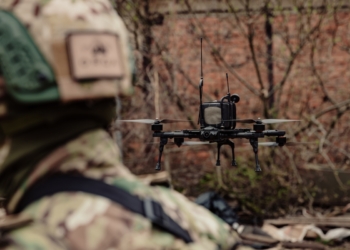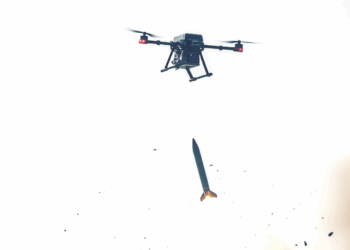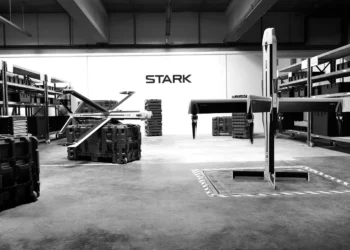In modern conflict, a new generation of defence startups is reshaping how militaries think about scale, autonomy, and control. Ark Robotics is one of them. Founded during the early phases of Russia’s full-scale invasion of Ukraine, the company emerged from a group of engineers building ground-based robots as a weekend project. What began as ad hoc experimentation has turned into a structured effort to solve one of the most pressing problems in military robotics: the pilot bottleneck.
“Yeah, so we basically started building a bunch of crazy Kamikaze UGVs that turned out more effective than we expected them to be,” said founder Achi Takagama. “It was literally a weekend project with friends, which escalated quickly to what is now Ark.”
Over time, Takagama and his crew learned what worked… and what didn’t.
“And really the tipping point for us as a company was when the first drones hit the battlefield and then we saw that the whole story is not about the drones, it’s about the pilots.”
“Because the pilots in the current concept of operations need to be by the soldiers and we send them to the very edge of the battlefield. They sit in trenches piloting the drones in basically line of sight operations. What we realised then was that the pilots are also the biggest bottleneck to scale the system.”
“If you want to send 100,000 drones, you also need to scale the number of pilots,” he said. “That doesn’t work.”

Ark’s solution is to multiply operator capacity. The company is building what it calls “collaborative autonomy”—a system that allows one pilot to operate multiple drones, with autonomy handling the low-level execution while humans retain control of critical decisions. This approach pushes autonomy out of the vehicle and into the network, allowing for faster decision-making without handing off lethal control to machines. The company’s architecture is designed to be modular, operator-centric, and flexible enough to support both small tactical missions and large coordinated swarm deployments.
“We have been working on the system that would allow us to achieve a key things. First, we take the pilots away from the battlefield to a safe place in the rear. And second is give them the operational leverage for one pilot to pilot multiple systems, . And this operator leverage is kind of the main metric that we are trying to scale with our different products, achieving more more autonomy both on the system level and on the network level. And the long-term vision for the company is really to build what we call collaborative autonomy.”
Beyond Ukraine
While Ark’s early deployments are tied to Ukrainian operations, the company’s ambitions are broader. Takagama is vocal about the strategic gap in European defence planning. “Europe doesn’t have the manpower to keep pace with high-scale drone deployments unless it adopts a different operational model,” he said. “One drone per pilot is a dead-end.”
In Ukraine, drones have shifted from tools of infantry support to independent assets conducting surveillance, jamming, and kinetic operations deep behind enemy lines. Ark believes this is only the beginning. Their technology is designed to anticipate a future where tens of thousands of autonomous or semi-autonomous drones operate simultaneously across an entire theater—something few countries are currently prepared to support.
The challenge, as Ark sees it, is not just technical. It’s doctrinal. European militaries still largely think in terms of incremental upgrades to legacy systems. But the shift toward drone-centric warfare requires an overhaul in logistics, command structure, and even force composition. Ark points to Ukraine’s decision to create a dedicated branch of unmanned systems as a model. The company is now engaging with governments and defence ministries across Eastern Europe to help accelerate this transformation.
Urgency and Scale
Ark recently raised to scale operations and expand across Europe. Their goal is not just to sell software and hardware, but to push governments to rethink how they approach defence autonomy. Takagama is blunt about the stakes: “If the West doesn’t move fast, it will be outpaced. You can have 1,000 drones in a warehouse, but without the systems and doctrine to operate them, they’re just dead weight.”
The threat isn’t theoretical. Russia is reportedly manufacturing tens of thousands of drones per month. Without scalable command and control, even a well-armed country will struggle to respond effectively to mass drone strikes—particularly those targeting infrastructure deep in the rear.
Ark’s warning is clear: the war of the future won’t be won by matching drone-for-drone. It will be won by building systems that can manage mass with intelligence and control. Collaborative autonomy, they argue, is the only way forward.
Ark Robotics represents a new kind of defence company: young, agile, and shaped by battlefield realities rather than procurement cycles. Its leadership has seen firsthand how quickly technology—and doctrine—must change. As the company expands from Ukraine into broader European markets, it brings with it not just tools, but a vision: one where defence autonomy is scalable, strategic, and controlled by humans—not constrained by them.












